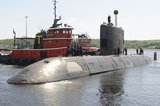Euronaval: EDA Marsur project reaches operational status
The European Defence Agency’s Maritime Surveillance (Marsur) project has reached operational status, it was announced at Euronaval in Paris on 27 October.
Marsur aims to improve the common ‘recognised maritime picture’ between European maritime information systems. The system facilitates exchange of operational maritime information and services such as ship positions, tracks, identification data, chat or images between the vessels of 17 member states plus Norway.
The interface is installed in each participating navy’s operational headquarters. A key characteristic of the Marsur network is that there is no central EU component that collects and distributes information. Each Member State is responsible for correlating its own data with the data received from other countries, and for boosting the services within the community.
Marsur is designed to become the potential ‘military layer’ of the wider Common Information Sharing Environment (CISE) project led by the European Commission. Marsur could work in conjunction with other systems of systems to ensure efficient interaction with other European maritime security stakeholders and also in support of CSDP missions.
Claude-France Arnould, chief executive, EDA, said: ‘Marsur is a great example of efficient pooling and sharing of existing capabilities. The project has now reached the point where it is ready to be used by European navies.’
More from Naval Warfare
-
![Maritime defence in the Mediterranean faces challenges from vulnerable land power]()
Maritime defence in the Mediterranean faces challenges from vulnerable land power
As an indispensable energy crossroads, the Mediterranean is at serious risk from grey zone disruption. As navies increasingly employ AI data centres, what happens when cutting-edge defence technologies rely on the very infrastructure most susceptible to hybrid tactics?
-
![US Navy to conduct an experimentation campaign with emerging tech in 2026 and 2027]()
US Navy to conduct an experimentation campaign with emerging tech in 2026 and 2027
The Technology Operational Experimentation Events will inform future requirements as the US Navy looks for innovative solutions across three key operational domains.
-
![Future Canadian Continental Defence Corvette will provide “Halifax-equivalent capabilities”]()
Future Canadian Continental Defence Corvette will provide “Halifax-equivalent capabilities”
Although the CDC project is still in its early stages, the Canadian Department of National Defence already has some requirements for the future platforms.





















